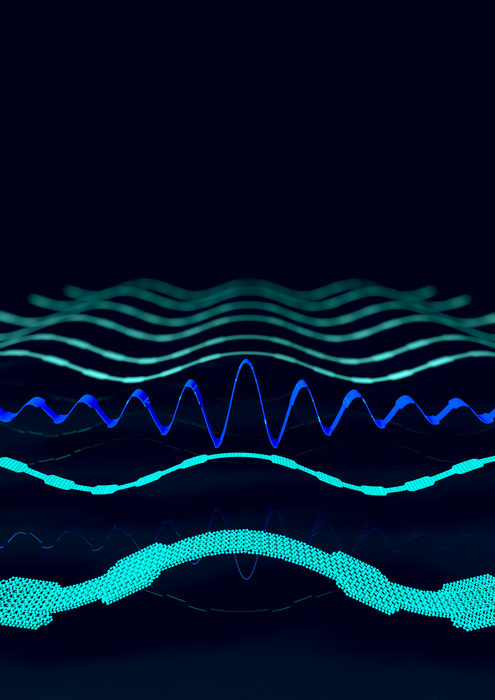When a string is tightened e.g., when tuning a guitar, it vibrates faster. But in the case of nano-sized strings, augmented tension also decreases, or “dilutes,” the loss of the string’s vibrational modes.
 Artist’s rendition of the vibration patterns of nanoscale crystalline silicon strings. Image Credit: Daniele Francaviglia.
Artist’s rendition of the vibration patterns of nanoscale crystalline silicon strings. Image Credit: Daniele Francaviglia.
This effect, called “dissipation dilution.” has been manipulated to build mechanical systems for quantum technologies, where engineered, tensioned nanostrings with a thickness of merely a few tens of atomic layers oscillate over ten billion times after being plucked just one time. The equivalent on a guitar would be a chord heard for approximately a year after being plucked.
Scientists at EPFL, guided by Professor Tobias J. Kippenberg, have currently made a simple observation regarding crystal oscillators, which are universally used in electronic systems and are identified to experience very small mechanical energy loss at low temperatures.
The scientists established that, if a crystalline material with nanoscale thickness is extended with high tension and preserves its atomic order, it would be a good contender for the production of strings with long-lived acoustic vibrations. Details of the study have been published in the journal Nature Physics.
We chose strained silicon films because it is an established technology in the electronics industry, where they are used to improve the performance of transistors. Strained silicon films are therefore commercially available in extremely small thicknesses of about 10 nanometers.
Dr. Nils Engelsen, Study Author, EPFL
A huge challenge is that the nanostrings must possess extreme aspect ratios. In this article, the nanomechanical devices measure 12 nanometers in thickness and up to 6 millimeters in length. If such a nanostring was constructed standing erect, with a foundation diameter equal to that of the Burj Khalifa tower, its tip would exceed Medium Earth Orbit, where GPS satellites orbit the Earth.
These structures become fragile and susceptible to tiny perturbations during the last steps of their microfabrication. We had to completely revamp our fabrication protocol to be able to suspend them without catastrophic collapse.
Alberto Beccari, Study First Author and PhD Student, Kippenberg’s Lab, EPFL
The strained silicon nanostrings are especially remarkable for quantum-mechanical experiments, where their low dissipation rate offers superior isolation from environmental disruption, enabling the formation of high-purity quantum states.
A long-standing quest in fundamental physics is to study and extend the size and mass scales of objects that exhibit quantum-mechanical behavior, before the ever-increasing random ‘kicks’ and fluctuations from the hot, noisy environment force them to behave according to the laws of Newton mechanics.
Alberto Beccari, Study First Author and PhD Student, Kippenberg’s Lab, EPFL
“Quantum-mechanical effects have already been observed with mechanical resonators of the same size and mass, at temperatures close to the absolute zero. In addition, these nanostrings could be used as precision force-sensors, being subject to all sorts of interactions — for example to the minuscule radiation pressure of light beams, to weak interactions with dark matter particles and to magnetic fields produced by subatomic particles,” Beccari added.
All the samples were created at the Center of MicroNanoTechnology (CMi) at EPFL.
Journal Reference:
Beccari, A., et al. (2022) Strained crystalline nanomechanical resonators with quality factors above 10 billion. Nature Physics. doi.org/10.1038/s41567-021-01498-4.